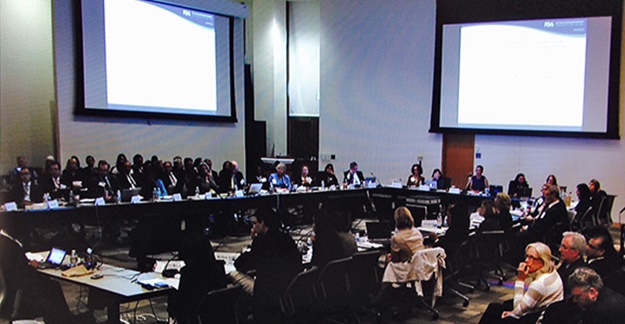FDA Drug Approvals & Advisory Committees
Do you want drugs to get to the market faster? Is safety a higher priority for you? What about who gives advice to the U.S. Food and Drug Administration (FDA), should it only be people who have no financial conflict of interest? I had the opportunity to meet with Robert Calif, Commissioner of the FDA, a couple of weeks ago. I went as MedShadow’s representative member of the Patient, Consumer, and Health Coalition, a group of organizations that educate, inform, and empower those concerned with the overuse of medicines and medical devices. As a group, we are supportive of the FDA, but feel there could be improvements. This meeting was to present our suggestions about FDA drug approval to Commissioner Califf directly.
Commissioner Califf had specifically requested to hear our thoughts on improving Advisory Committees, and therefore I was asked to speak alongside Kim Witczak, founder of Woody Matters. We were each given five minutes. Kim and I are both consumer representatives on different committees. Normally, Advisory Committee meetings are obscure things, followed only by pharmaceutical companies, the health press, and drug/medical device activists – like Kim and me.
Advisory committees came into the spotlight during the news coverage of COVID-19 vaccinations reviews and approvals. From that much wider-than-usual coverage, many found out that advisory committees are made up of medical professionals (mostly doctors), with a single, voting consumer representative (and sometimes a patient representative, too).
These committees are asked to review piles of data on a particular drug collected by the FDA and the “Sponsoring Company” (the pharmaceutical manufacturer), sit through lengthy presentations reviewing the data, and then discuss and vote on approval.
Background: Here’s How FDA Advisory Committees Work
Advisory committee meetings are called by the FDA to provide independent expert advice on a proposed drug or device’s approval. For this article, I’m only going to cover drugs. Devices have a similar, but slightly different, approval process.
There are 49 different Advisory committees, each focusing on a different medical specialty. The advisory committees are made up of about 20 members, nearly all doctors with a specialty in the area of the committee. Also on the committees are one consumer representative(voting), one industry representative(nonvoting), and sometimes a patient representative(may be voting or nonvoting).
The FDA reviews hundreds of new drugs each year approving some, but not all. The advisory committee generally meets only to review new, “novel” drugs (medications unlike any previous meds on the market) or illicit drugs that may have a medical use (like cannabis or synthetic opioids). Not all novel drugs get an advisory committee meeting. In fact, it varies widely.
Meetings/Year and Novel Drugs Approved
| Year | Meetings | Novel Approved Drugs |
| 2022 | 30 | 37 |
| 2021 | 36 | 50 |
| 2020 | 20 | 25 |
| 2019 | 52 | 59 |
The FDA agrees with the recommendations of its advisory committees nearly 80% of the time, according to a recent analysis. But the FDA is not obligated to follow the advice of the Committee.
The Comments We Made to the FDA
1. We would like transparency in the process of determining when the FDA calls an advisory committee for FDA drug approval or a new or changed drug/device.
We told Commissioner Califf that we are uncomfortable with the lack of transparency on the decision to hold an advisory committee meeting or not. Is it when the drug is controversial? When the data is not clear? When the risk-benefit profile is close? How close? We would like guidelines and consistency.
The FDA Drug Safety and Risk Management Advisory Committee (DSARM) has a special role indicated in its name. Rather than being assigned to one drug or device, DSARM is usually assigned to meet alongside the assigned committee when an added layer of safety review called for. I’m the single, consumer representative member of DSARM.
When the COVID-19 vaccines and treatments were reviewed, DSARM was not invited to join, even though safety was a primary concern. When Adulhelm was reviewed, DSARM was not invited. Aduhelm is the Alzheimer’s drug that causes a variety of significant, life-altering side effects like brain hemorrhages in a significant number of patients. This is clearly a drug where risk has to be carefully calculated against possible benefit.
In addition for clarity on when a drug comes before any advisory committee, we also want general guidelines on when DSARM is included.
2. We would like the FDA to reconsider who should be a member of an advisory committee.
Doctors and other medically trained people should not be allowed to fill the consumer or patient representative slots. The medical training received teaches health professionals a perspective, a way of looking at a health issue, that is drug- and intervention-centric. Doctors are focused on solving the health issue, not always on what quality of life means to the individual patient.
Health professionals are improving greatly in including the patient in treatment decisions, but the role of the consumer representative is to bring the outside perspective, a reminder that, for example, many drugs that are listed as “well tolerated” may still cause nausea as a side effect. Being up several times a night to vomit, or to be unable to eat because of a queasy stomach, may dramatically affect the life of an hourly worker who has no sick day pay. That person simply cannot stay on that drug.
And yet, I am the first non-doctor to sit in the consumer representative seat since the inception of DSARM, more than 15 years ago.
Consumer Representatives also have no financial incentive to get a product to market quickly. All members of the committees have to fill out a financial Conflict of Interest Statement before every meeting and list any paid interaction with the pharmaceutical manufacturer of the drug being evaluated and all of the competing companies. If there is a Conflict of Interest that is waived for a member of the committee (because we have a need for his/her unique knowledge) it is announced at the beginning of every meeting. In my experience, this is rare.
There are other ways conflicts take shape. For example, specialists are under pressure from their patients for new, better drugs, and, of course, doctors want that for them. Confronted with disease and patients’ pain daily, of course doctors are anxious to have new and better drugs as soon as possible.
In advisory committee meetings, I’ve heard doctors support a third tier medicine being proposed (a drug for an illness that already has several drugs on the market that are either more effective or have fewer side effects). Doctors support second and third tier meds because there are always some people who either don’t respond to first tier drugs or can’t tolerate them.
Some breakthrough drugs can increase the number of people who want to see specialists (increasing the size of the market). Look at the frenzy around Wegovy and the sister weight-loss drugs. As predicted, weight-loss specialists are inundated with new patients. All these specialists have a financial benefit from the approval of Wegovy-like drugs even if they were never paid as a consultant, speaker, or researcher on the drug.
Consumer representatives are not insensitive to the pressing needs for drugs that can address or cure disease. Our role, however, is to bring the patients’ perspective into the risk-benefit consideration of new drugs. We typically ask: why did so many people drop out of a clinical trial? Is it because the side effects were so taxing that many can’t tolerate the drug? Is another drug needed to manage a side effect (like constipation)? Did the people in the trial represent those who are most likely to need the drug? For example, diabetes is higher in the Black population, so we want to see enough Black trial participants to ensure that the drug is effective and safe for them, too.
Most of the consumer representatives on the advisory committees that I’ve met have been like me, people who were affected by a drug’s adverse effect and went on to become activists in drug safety. Nearly all were volunteers, and any organization they were affiliated with did not accept pharmaceutical support.
Without pharma support, there’s not a lot of money to be made in drug safety, so there aren’t many of us who can afford to spend our time this way. Also, we have to have an interest and knowledge level in the medical field, and we are expected to represent the interests of all potential patients.
Therefore, we understand that it can be difficult to find an appropriate person for the consumer representative role. We suggested to Commissioner Califf that, instead of filling empty consumer representative positions with doctors, nurses, and pharmacists, they should instead reach out to public health professionals. Public health professionals are scientists, but not medical doctors. They study the entire population for causes of health problems (like obesity, asthma, ADHD, etc.) and implement programs for solutions on a regional or national scale.
Kim and I also suggested that there should be more than one consumer representative on a committee. One consumer voice speaking out on a panel of 15 to 20 doctors may not be strong enough. Doctors prescribe medicine, patients have to live with it.
Advisory committee members do not receive any training. It would be helpful if all members of the committees were required to take at least one training program on the FDA drug approval process and the REMS labels (Risk Evaluation and Mitigation Strategies).
3. FDA Advisory Committee meetings need to be in person.
During the pandemic, the FDA pivoted from in-person to video meetings. This was a necessary step to keep the approval processes moving. But now that we are past the public health emergency stage, we need to get back to in-person meetings.
These meetings, and the topics being discussed, are too important to be held virtually. When on camera, we miss the human interaction, connection, eye contact, conversations, and the nuances in the discussions.
When sitting in front of a computer, distractions are difficult to control. A coworker may ask a quick question or a message may demand attention. The agendas used to have regular 15-minute breaks for coffee, water, and bathrooms. The video meetings don’t have those scheduled breaks. But it’s reasonable to assume that most people will need to step away from the computer for the bathroom or water and without scheduled breaks, they will miss some of the presentation or discussion. The sponsors, FDA presentations, and the public speakers deserve the committee’s complete attention for the entire time.
Discussion without being able to see all the participants all the time makes it hard to discern who is speaking or asking a question, even if they self-identify. In-person meetings facilitate a back-and-forth discussion. In-person exchanges tend to have a richer dialogue.
Allowing the public to view meetings on screen (or in person if preferred), however, adds an invaluable option. Many members of the general public may not have the opportunity to attend without such virtual access.
4. We agree that yes/no votes are not always a productive way to end the meeting. Let’s look at options.
Commissioner Califf has spoken publicly about changing the advisory committee votes to be less important and to increase the emphasis on discussion.
Presently, all advisory committee meetings have a presentation of data from the sponsoring company and then a presentation from the FDA on the same studies. They often interpret the data differently. After questions from the advisory committee members and time for speakers from the public who have signed up, the committee is presented with a short list of questions, some of which the FDA asks us to vote on, others we are only asked to discuss. After a vote, each person on the advisory committee in turn announces a yes, no, or abstain vote and has a moment to explain what factors were most important in his or her decision.
We agree with Commissioner Califf that the discussions and the rationales for voting are more informative than a yes or no. Questions can be limiting and nuances are lost, with sometimes significant concerns not being reflected in a vote.
We suggested that the voting change to be similar to the process that the Medicare Evidence Development and Coverage Advisory Committee (MEDCAC) uses. They offer a range of votes, from one to five, usually using phrasing like, how confident are you in the research presented? This allows more nuance in the outcome of the vote.
5. Intellectual conflicts of interest are most often raised against consumer representatives and are quite often driven by pharmaceutical influence.
Disqualification from sitting in a specific meeting for an intellectual conflict of interest doesn’t happen often, but it has happened to Kim and to Dr. Sidney Wolfe when he was the consumer representative on DSARM. Those objections were raised by the sponsoring pharmaceutical company because of articles that each had published questioning a drug’s efficacy and/or safety profile.
Kim and I told Commissioner Califf that this was an unfair and an illogical standard. Conflicts of interest should be raised only when a person has a significant motivation or financial incentive to support or oppose a drug that is being reviewed. No one should be considered conflicted simply because they are familiar with a drug (through prescribing or research) and have a preliminary opinion.
Of course, the FDA appropriately recuses from a meeting any doctor on the panel who has been paid by the sponsoring pharmaceutical company to conduct research, speak publicly, or to advise on a drug coming before the advisory committee meeting. But, we do not consider it to be a conflict of interest for a consumer representative to have published for no pay (for example) an Op-Ed piece on a drug long before a committee meeting has been announced
Consumer Reps are advocates and speak in public or publish information on topics that they are interested in and on which they have knowledge. Doctors prescribe drugs, which is an endorsement to the patient of the doctor’s belief in the drug’s efficacy and safety. But doctors who have prescribed a drug are not considered in conflict of interest. Doctors who work in universities that have research contracts with sponsoring companies, but don’t work on that contract themselves directly, are not considered in conflict. Doctors in industries that will see a financial boost with a new mega drug (like Wegovy weight loss drug) are not considered in conflict. Therefore, we conclude that consumer reps who have familiarized themselves with the research and clinical effects of a drug, and spoken or written about it publicly without pay, should also not have a conflict of interest.
———————————
FDA attendees: Robert Califf (Commissioner, virtual due to exposure to viruses), Peter Marks (Director, CBER, virtual), Owen Faris (OPEQ Principal Deputy Director, CDRH, virtual); In person: Julia Tierney (Chief of Staff, Office of the Commissioner), Jacqueline Corrigan-Curay, (Principal Deputy Director, CDER), Dayle Cristinizio (Director, Stakeholder Engagement, Office of External Affairs), Hilary Maston (Chief Medical Officer), Namandje Bumpus (Chief Scientist, AdCom responsibilities), Kaveeta Vasisht (Assoc Commissioner for Women’s Health), Jennifer Dooren (Director Communications and Public Engagement, Food Safety).
Coalition Attendees: In Person: Thomas Eagen (NCHR), Maria Gmitro (BISA), Denise Hyater-Lindenmuth (NWHN), Patricia Kelmar (U.S. PIRG), Suzanne Robotti (MedShadow), Kim Witczak (WoodyMatters), Diana Zuckerman (NCHR). Virtual: Tahir Amin (I-MAK), Wendy Dolin (MISSD), Helen Haskell (MAME), Rex Johnson (WAPS), Katherine Leon (SCAD Alliance), Judy Norsigan (OBOS), Linda Radach (PSAN), Reshma Ramachandran (DFA), Brian Ronholm (Consumer Reports), Tess Schulman (Medical Device Problems), Robin Strongin (NCL), Dru West (USAPN), Sophia Phillips (on behalf of the Coalition).






